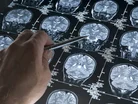Modern methods of radiosurgery are transforming brain tumour

The majority of skull base tumours are benign and slow growing, they can be complex to treat and present a risk to brain function. The bones that form the skull base also form the eye socket, nasal cavity roof, part of the sinuses and the bones surrounding the inner ear. An abnormal growth here can put specific brain functions at risk and so often warrant treatment. As these tumours form deep within the skull base, surgical excision can be difficult and requires a specialised team, such as those at Queen Square Gamma Knife centre, with Consultant Neurosurgeon’s like Patrick Grover.
“There can be a risk of damage to the nerves and blood vessels surrounding the tumour, in some cases making surgery unfeasible,” Grover explains. “Treatments for brain tumours are regularly advancing as developments in imaging and technology are integrated into modern medical practice. Focal radiation treatments such as Gamma Knife radiosurgery have transformed the management of these tumours over recent decades.”
Here, Grover tells us more.
Gamma Knife radiosurgery – non-invasive focal therapy
The symptoms of a skull base tumour appear slowly as they grow. Specific symptoms will depend on the type, location and size of the tumour, but common symptoms include:
- Weakness
- Hearing loss
- Numbness
- Vision loss
- Double vision
- Problems with balance.
Radiation can be delivered in different forms. The most focussed and targeted is termed ‘stereotactic radiosurgery’.
“For well circumscribed, deep-seated tumours, this is the best option as this form of treatment can target a high dose of radiation to the tumour, whilst minimising any spread to the normal brain,” Grover explains. “This is because it uses up to 192 focussed beams of gamma radiation which individually carry a low dosage and converge at a single point to deliver a high dosage of radiation, targeting the intended area only. One of the most common forms of stereotactic radiosurgery is called ‘Gamma Knife radiosurgery’.”
This technique achieves the highest level of accuracy by using a stereotactic frame that is fitted to the head during the treatment. The other advantage of radiosurgery is that it is non-invasive, and therefore in some circumstances it avoids the need for open surgery. It is convenient and performed as a day case.
However, it does have some limitations and cannot be used to remove a tumour that is already causing symptoms. The aim is to arrest growth, and generally, a tumour that is less than 3cm in size can be considered for radiosurgery. Smaller is better for this treatment type, as larger tumours can be susceptible to swelling reactions in the brain. Larger or more diffuse tumours may be considered more suitable for conventional ‘fractionated’ radiotherapy instead over a number of sessions of treatment.
“The majority of tumours, particularly those of a smaller size, are suitable for treatment with stereotactic radiosurgery techniques such as Gamma Knife radiosurgery. As this has the benefit of being non-invasive, it has a lower risk of injury – for example, to the facial nerve, in the region of 1% of cases or less,” Grover continues. “Gamma Knife radiosurgery does not remove the tumour, but can help prevent further growth in approximately 95% of tumours, or more, depending on the size. There are risks of exacerbating balance problems, for example, for a period of time, or accelerating hearing loss, but compared with ongoing tumour growth these side effects are usually well tolerated. Treatment is carried out as a day case, and normal activities including work can continue within a few days.”
Skull base tumours treated with Gamma Knife and medication
In some cases, the scan may reveal that the tumour is causing swelling in parts of the brain - this is called ‘oedema’.
“This oedema can cause symptoms in addition to those that result purely from the pressure of the tumour itself. If the oedema is significant and causing symptoms, treatment with steroid medication, such as ‘dexamethasone’ may be needed for a period of time as decided by the clinician.”
However, because long term use of steroids is associated with medical complications such as weight gain and osteoporosis, their use is usually restricted to short periods.
Avoiding the facial nerve in surgery
The crucial aspect of brain tumour surgery is to safely remove enough tumour without damaging normal structures, such as the facial nerve.
“During surgery this nerve is monitored with an electrophysiological probe to ensure it is functioning normally,” says Grover. “It is our practice to perform ‘facial nerve sparing’ surgery, where a portion of tumour is often deliberately left behind on the nerve to preserve its function. If this residual tumour grows subsequently, it can then be safely treated with radiosurgery in the future.”
The majority of tumours can be observed in the first instance with surveillance imaging. This period is important to determine the behaviour of the tumour and a six-monthly MRI scan is often appropriate.
“If new symptoms develop in the meantime, the MRI scan can be brought forward. The observational period allows time to fully characterise the tumour diagnosis so that the most appropriate treatment options are considered and decided upon. In these circumstances, if tumour growth is demonstrated at six months, a clear and quick decision on the best form of treatment can be made,” Grover concludes.
- UNEP: Tackling Climate Change to Decrease Health Issue LoadSustainability
- Vaccines, Dementia & Food: The Week's Top Healthcare StoriesMedical Devices & Pharma
- The Toxic, Food-Borne Chemicals Costing Healthcare TrillionsHospitals
- How Amgen Combines Life-Saving Biotech & SustainabilitySustainability



